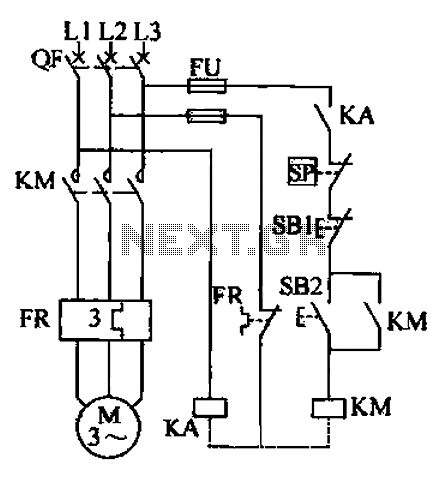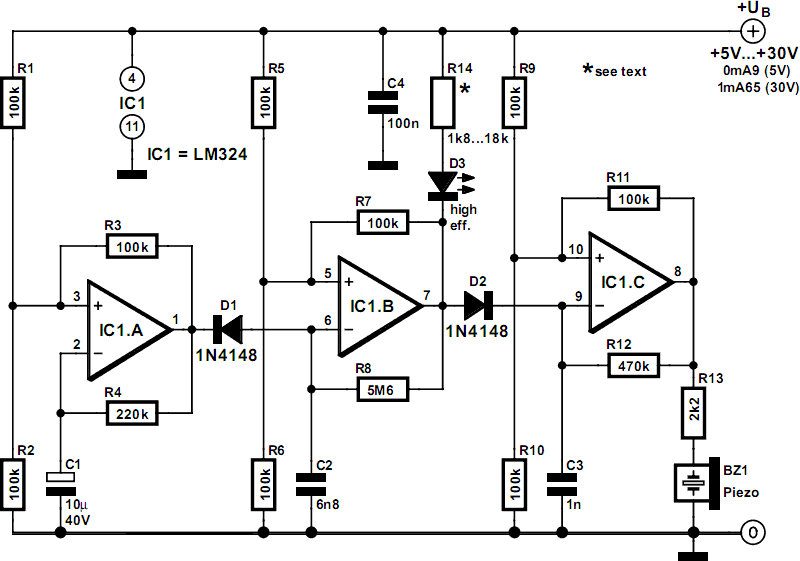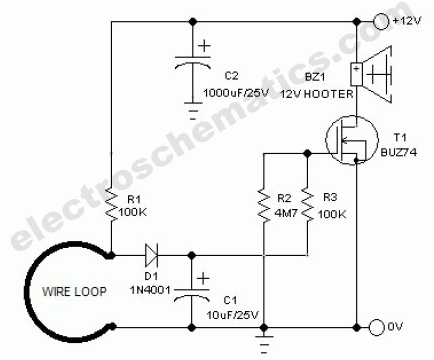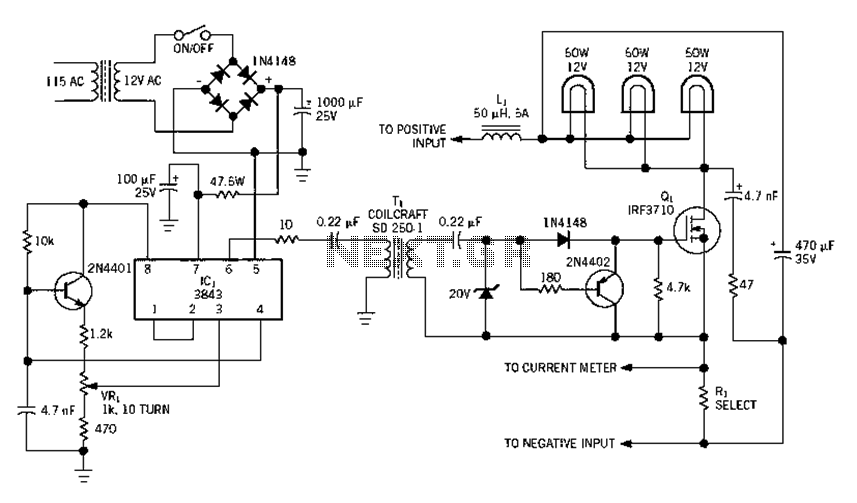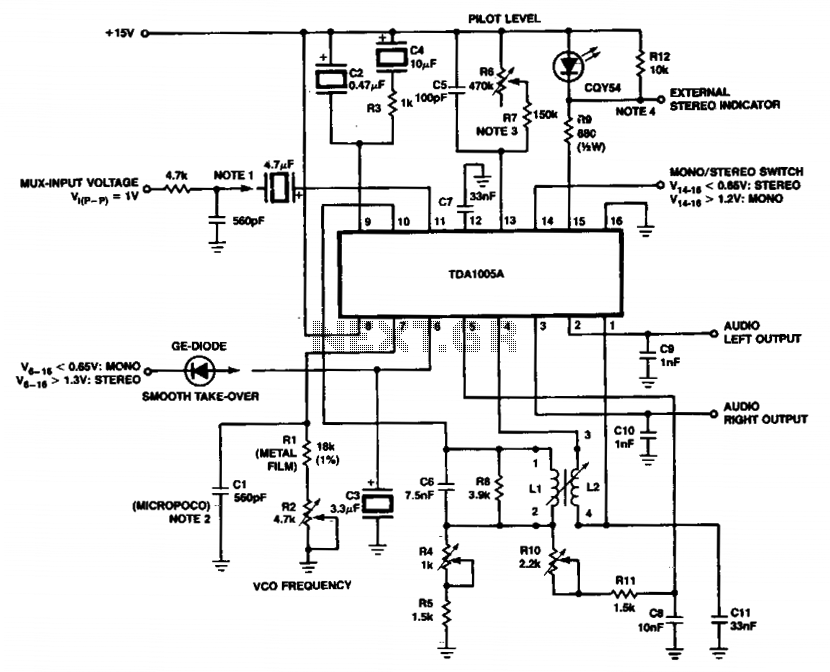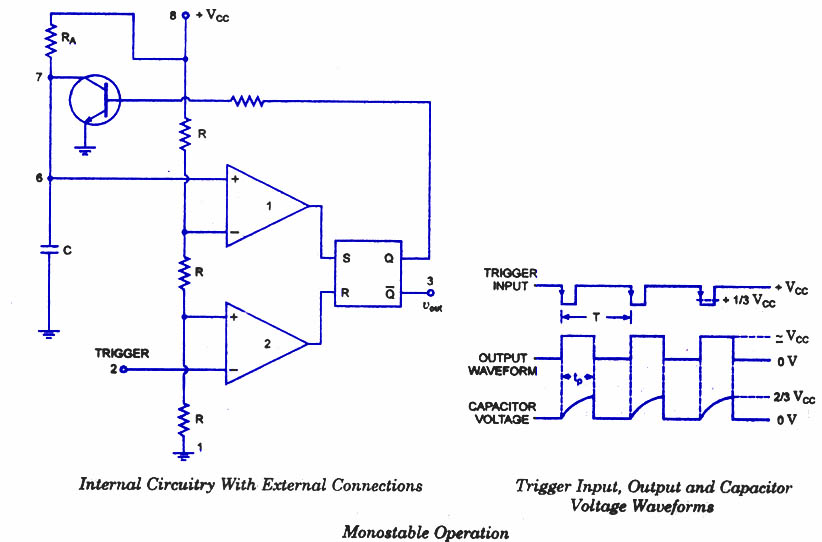
dtmf dual tone multi frequency decoder circuit schematic using M8870 IC
%2Bdecoder%2BCircuit%2Bschematic%2Busing%2BM8870.png)
This DTMF (Dual Tone Multi Frequency) decoder circuit identifies the dial tone from the telephone line and decodes the key pressed on the remote telephone. For the detection of DTMF signaling, the IC MT8870DE, a touch tone decoder IC, is utilized. It decodes the input DTMF into five digital outputs. The MT8870 DTMF decoder IC employs a digital counting technique to ascertain the frequencies of the limited tones and to confirm that they correspond to standard DTMF frequencies. The DTMF tone represents a form of one-way communication between the dialer and the telephone exchange. The entire communication system comprises the touchtone initiator and the tone decoder or detector. The decoded bits can be interfaced with a computer or microcontroller for various applications, such as remote control of home or office electrical appliances using a telephone network, cell phone-controlled home appliances, and mobile phone-controlled robots.
In the early days, telephone systems operated with human operators in telephone exchange rooms. The caller would pick up the phone and instruct the operator to connect their line to the destination, which was a manual switching process. As technology advanced, pulse or dial tone techniques were developed for telephone communication switching, employing electronics and computers to facilitate switching operations. DTMF has become the standard technique used in mobile and telephone communication systems. DTMF keypads are found in nearly all landline and mobile handsets, making this technology essential in telephone switching centers to identify the number dialed by the caller. DTMF signals can be extracted directly from the microphone pin of a cell phone device. By cutting the microphone wire, two wires—red and green—can be identified, with the red wire serving as the DTMF input to the circuit. The signals from the microphone wire are processed by the DTMF decoder IC, which generates an equivalent binary sequence as parallel outputs, such as Q1, Q2, Q3, and Q4.
An integrated operational amplifier is present within the MT8870 decoder IC. Electrical signals from the microphone pin are directed to the inverting input of the op-amp through a series resistance (100kΩ) and capacitance (0.1 µF). Pin 3 (GS) serves as the output of the internal op-amp, with feedback provided by connecting the output pin (pin 3 - GS) to the inverting input pin (pin 2 - IN-) via a resistor (270kΩ). The op-amp output is then processed through a pre-filter, which consists of low and high group filters (filter networks). These filters utilize switched capacitors to separate DTMF tones into low and high group signals, with high group filters bypassing high frequencies while low group filters pass low frequencies. The entire process, from frequency detection to data latching, is managed by a steering control circuit composed of St/GT, Est pins, a resistor (390kΩ), and a capacitor (0.1 µF).This DTMF (Dual Tone Multi Frequency) decoder circuit identifies the dial tone from the telephone line and decodes the key pressed on the remote telephone. Here for the detection of DTMF signaling, we are using the IC MT8870DE which is a touch tone decoder IC.
It decodes the input DTMF to 5 digital outputs. The M-8870 DTMF (Dual Tone Multi Frequency ) decoder IC uses a digital counting technique to determine the frequencies of the limited tones and to verify that they correspond to standard DTMF frequencies. The DTMF tone is a form of one way communication between the dialer and the telephone exchange. The whole communication consists of the touchtone initiator and the tone decoder or detector. The decoded bits can be interfaced to a computer or microcontroller for further application (For example, Remote control of home/office electrical appliances using a telephone network, Cell Phone controlled home appliances, Mobile phone controlled robot, etc.
). Recommended for better understanding: In the premature days, our telephone systems were operated by human operators in a telephone exchange room. The caller will pick up the phone, giving instruction to the operator to connect their line to the destination.
It is a kind of manual switching. As more and more people entered in the telephone technology as useful communication gear, manual switching becomes a time consuming tedious task. As technology established, pulse or dial tone technique were invented for telephone communication switching.
It employs electronics and computers to support switching operations. DTMF is the ultimate technique used in any of the Mobile, Telephone communication systems. DTMF keypads are employed in almost all landline and mobile handsets. Thus this technology is used in the telephone switching centers to identify the number dialed by the caller. DTMF signals can be tapped directly from the microphone pin of cell phone device. Cut the microphone wire and you will get two wires red and green. The red wire is the DTMF input to the circuit. The signals from the microphone wire are processed by the DTMF decoder IC which generates an equivalent binary sequence as a parallel output like Q1, Q2, Q3, and Q4.
There is an inbuilt Op amp present inside the M-8870 decoder IC. The electrical signals from microphone pin are fed to inverting input of the Op Amp via a series of resistance (100k ©) and capacitance (0. 1 µF). Pin 3 (GS) is the output of internal Op Amp, the feedback signal is given by connecting the output pin (pin3- GS) to inverting input pin (pin2- IN-) through a resistor (270k ©).
The output of Op Amp is passed through a pre filter, low group and high group filters (filter networks). These filters contain switched capacitors to divide DTMF tones into low and high group signals (High group filters bypass the high frequencies whereas low group filter pass low frequencies).
The entire process from frequency detection to latching of the data, is controlled by steering control circuit consisting of St/GT, Est pins, resistor (390k ©) and a capacitor (0. 1 µF). 🔗 External reference
In the early days, telephone systems operated with human operators in telephone exchange rooms. The caller would pick up the phone and instruct the operator to connect their line to the destination, which was a manual switching process. As technology advanced, pulse or dial tone techniques were developed for telephone communication switching, employing electronics and computers to facilitate switching operations. DTMF has become the standard technique used in mobile and telephone communication systems. DTMF keypads are found in nearly all landline and mobile handsets, making this technology essential in telephone switching centers to identify the number dialed by the caller. DTMF signals can be extracted directly from the microphone pin of a cell phone device. By cutting the microphone wire, two wires—red and green—can be identified, with the red wire serving as the DTMF input to the circuit. The signals from the microphone wire are processed by the DTMF decoder IC, which generates an equivalent binary sequence as parallel outputs, such as Q1, Q2, Q3, and Q4.
An integrated operational amplifier is present within the MT8870 decoder IC. Electrical signals from the microphone pin are directed to the inverting input of the op-amp through a series resistance (100kΩ) and capacitance (0.1 µF). Pin 3 (GS) serves as the output of the internal op-amp, with feedback provided by connecting the output pin (pin 3 - GS) to the inverting input pin (pin 2 - IN-) via a resistor (270kΩ). The op-amp output is then processed through a pre-filter, which consists of low and high group filters (filter networks). These filters utilize switched capacitors to separate DTMF tones into low and high group signals, with high group filters bypassing high frequencies while low group filters pass low frequencies. The entire process, from frequency detection to data latching, is managed by a steering control circuit composed of St/GT, Est pins, a resistor (390kΩ), and a capacitor (0.1 µF).This DTMF (Dual Tone Multi Frequency) decoder circuit identifies the dial tone from the telephone line and decodes the key pressed on the remote telephone. Here for the detection of DTMF signaling, we are using the IC MT8870DE which is a touch tone decoder IC.
It decodes the input DTMF to 5 digital outputs. The M-8870 DTMF (Dual Tone Multi Frequency ) decoder IC uses a digital counting technique to determine the frequencies of the limited tones and to verify that they correspond to standard DTMF frequencies. The DTMF tone is a form of one way communication between the dialer and the telephone exchange. The whole communication consists of the touchtone initiator and the tone decoder or detector. The decoded bits can be interfaced to a computer or microcontroller for further application (For example, Remote control of home/office electrical appliances using a telephone network, Cell Phone controlled home appliances, Mobile phone controlled robot, etc.
). Recommended for better understanding: In the premature days, our telephone systems were operated by human operators in a telephone exchange room. The caller will pick up the phone, giving instruction to the operator to connect their line to the destination.
It is a kind of manual switching. As more and more people entered in the telephone technology as useful communication gear, manual switching becomes a time consuming tedious task. As technology established, pulse or dial tone technique were invented for telephone communication switching.
It employs electronics and computers to support switching operations. DTMF is the ultimate technique used in any of the Mobile, Telephone communication systems. DTMF keypads are employed in almost all landline and mobile handsets. Thus this technology is used in the telephone switching centers to identify the number dialed by the caller. DTMF signals can be tapped directly from the microphone pin of cell phone device. Cut the microphone wire and you will get two wires red and green. The red wire is the DTMF input to the circuit. The signals from the microphone wire are processed by the DTMF decoder IC which generates an equivalent binary sequence as a parallel output like Q1, Q2, Q3, and Q4.
There is an inbuilt Op amp present inside the M-8870 decoder IC. The electrical signals from microphone pin are fed to inverting input of the Op Amp via a series of resistance (100k ©) and capacitance (0. 1 µF). Pin 3 (GS) is the output of internal Op Amp, the feedback signal is given by connecting the output pin (pin3- GS) to inverting input pin (pin2- IN-) through a resistor (270k ©).
The output of Op Amp is passed through a pre filter, low group and high group filters (filter networks). These filters contain switched capacitors to divide DTMF tones into low and high group signals (High group filters bypass the high frequencies whereas low group filter pass low frequencies).
The entire process from frequency detection to latching of the data, is controlled by steering control circuit consisting of St/GT, Est pins, resistor (390k ©) and a capacitor (0. 1 µF). 🔗 External reference
